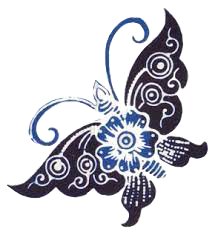East Kalimantan Batik's Distinct Designs: A Combination of Nature and Tradition
Throughout Indonesia, batik, a traditional fabric-dying method, is well-known for its elaborate designs and deep cultural importance. Every area has an own flair, and East Kalimantan is no exception. The region's varied cultural traditions and scenic beauty are vividly reflected in the batik produced here. This essay explores how the distinctive themes of East Kalimantan batik represent a fusion of nature and tradition.
On the island of Borneo, East Kalimantan is an area renowned for its diverse culture and abundance of natural resources. Indigenous customs and outside cultural interactions have shaped the centuries-long development of batik painting in this area. In the past, batik from East Kalimantan was mostly utilized in ceremonial settings to represent social standing and cultural identity.
East Kalimantan first encountered batik when traders and artisans from other parts of Indonesia migrated there, bringing the art form with them. Local craftspeople gradually blended their distinctive cultural components to produce a distinctive batik style that captures the natural surroundings and customs of the area.
The Heart of Batik in East Kalimantan
The seamless blending of traditional motifs and natural themes is what sets East Kalimantan batik apart. The themes, which depict many facets of local life, have profound cultural roots. In order to create a rich tapestry that conveys a tale of both nature and tradition, these patterns frequently take inspiration from East Kalimantan's beautiful landscapes, flora, and animals.
Traditional Motifs and Their Meanings
1. The Kayan Pattern
One of the most prominent motifs in East Kalimantan batik is the Kayan pattern, which originates from the Kayan ethnic group. This pattern is characterized by geometric shapes and intricate lines that mimic the natural forms found in the region. The Kayan pattern often includes elements such as spirals, waves, and interlocking shapes, symbolizing the flow of life and the interconnectedness of nature.
2. The Dayak Motif
The Dayak people, another indigenous group in East Kalimantan, have significantly influenced local batik designs. The Dayak motif is recognized for its bold and vibrant patterns, often featuring stylized representations of local wildlife, such as birds and insects. These motifs are imbued with symbolic meanings, representing strength, courage, and spiritual significance.
3. The Beruang Pattern
Inspired by the local fauna, the Beruang (bear) pattern is a popular motif in East Kalimantan batik. This design often depicts the bear in various poses, reflecting its importance in local folklore and as a symbol of power and protection. The Beruang pattern is typically rendered in earthy tones, reflecting the natural colors of the East Kalimantan landscape.
4. The Orchid Motif
East Kalimantan is home to a diverse range of orchid species, and the Orchid motif in batik reflects the region’s botanical richness. This pattern features delicate, stylized renditions of orchids, symbolizing beauty, grace, and the fleeting nature of life. The use of vibrant colors and intricate details in the Orchid motif highlights the region’s natural beauty and the craftsmanship of local artisans.
Techniques and Materials
East Kalimantan batik artisans employ a variety of techniques to create their unique patterns. The traditional method involves applying wax to fabric to resist dye, resulting in intricate designs. The use of natural dyes, often derived from local plants and minerals, adds to the authenticity and environmental sustainability of the batik.
The choice of materials also plays a crucial role in the final product. Traditionally, batik is made from high-quality cotton or silk, which allows the intricate designs to be showcased effectively. The fabrics are often hand-dyed, ensuring that each piece is unique and reflects the artisan’s skill and creativity.
Cultural Significance
The motifs of East Kalimantan batik are not merely decorative; they carry profound cultural significance. Each pattern tells a story and reflects the values, beliefs, and environment of the region. For the people of East Kalimantan, batik is a medium through which they express their identity, celebrate their heritage, and connect with their ancestors.
In ceremonial contexts, batik garments are worn to mark important life events, such as weddings and religious ceremonies. The choice of motifs and colors often carries specific meanings, and the process of creating batik is considered a sacred art form. By wearing batik, individuals honor their cultural traditions and maintain a connection with their roots.
Contemporary Influences and Preservation Efforts
In recent years, East Kalimantan batik has gained recognition beyond its traditional boundaries. Contemporary designers have incorporated traditional motifs into modern fashion, blending old and new to create innovative designs that appeal to a global audience. This fusion of tradition and modernity has helped raise awareness of East Kalimantan’s batik and promote its cultural heritage.
Preservation efforts are also underway to ensure that the art of batik continues to thrive. Organizations and local communities are working to support artisans, promote traditional techniques, and educate younger generations about the importance of batik. These initiatives are crucial for maintaining the cultural significance of East Kalimantan batik and ensuring its future.
Conclusion
The batik of East Kalimantan is a remarkable example of how tradition and nature can intertwine to create a unique and meaningful art form. Through its intricate motifs and vibrant patterns, East Kalimantan batik reflects the region’s rich cultural heritage and natural beauty. As the art form continues to evolve and gain recognition, it serves as a testament to the creativity and resilience of the local artisans. By appreciating and preserving this cultural treasure, we honor the legacy of East Kalimantan’s batik and ensure that its beauty endures for future generations.

